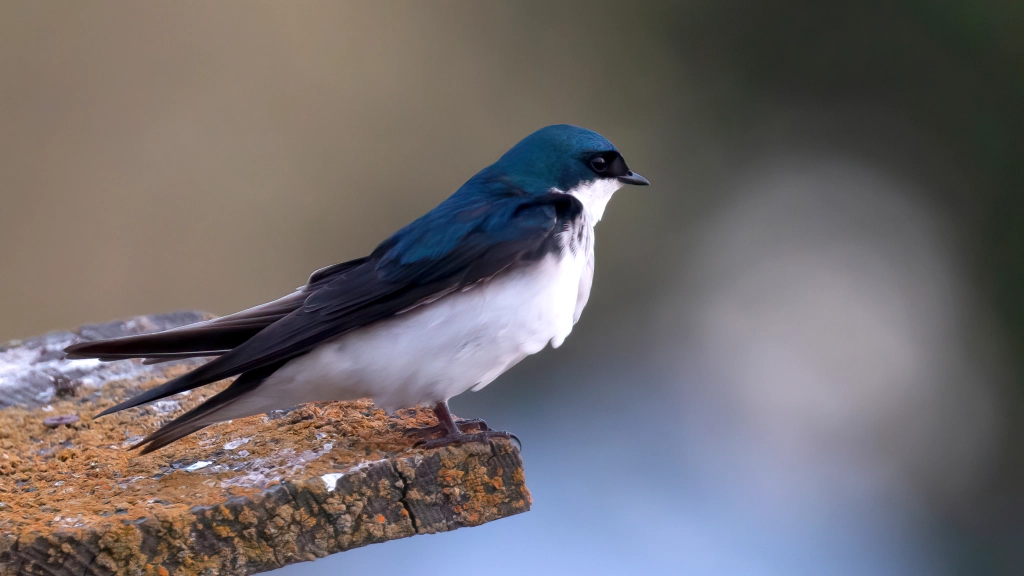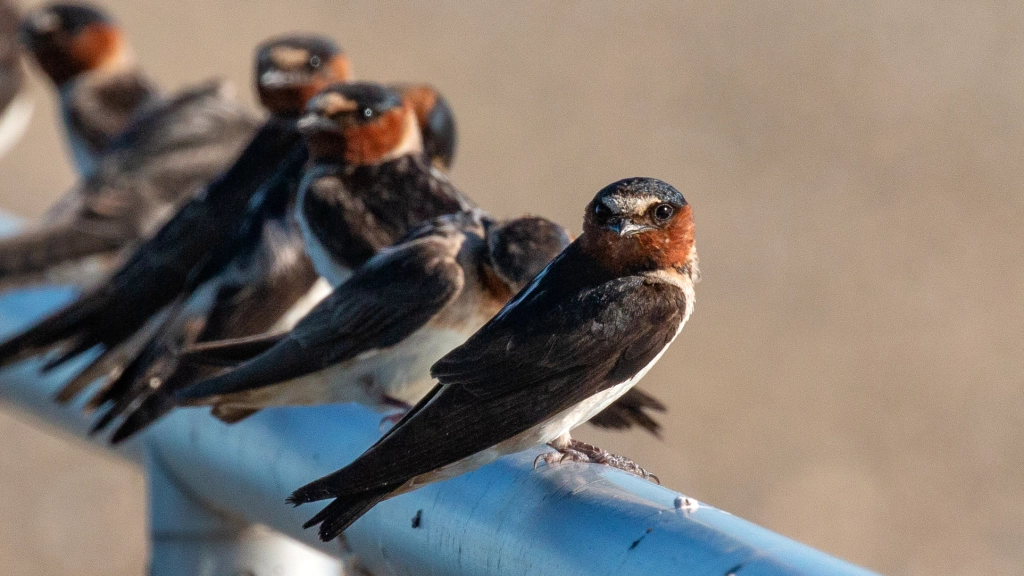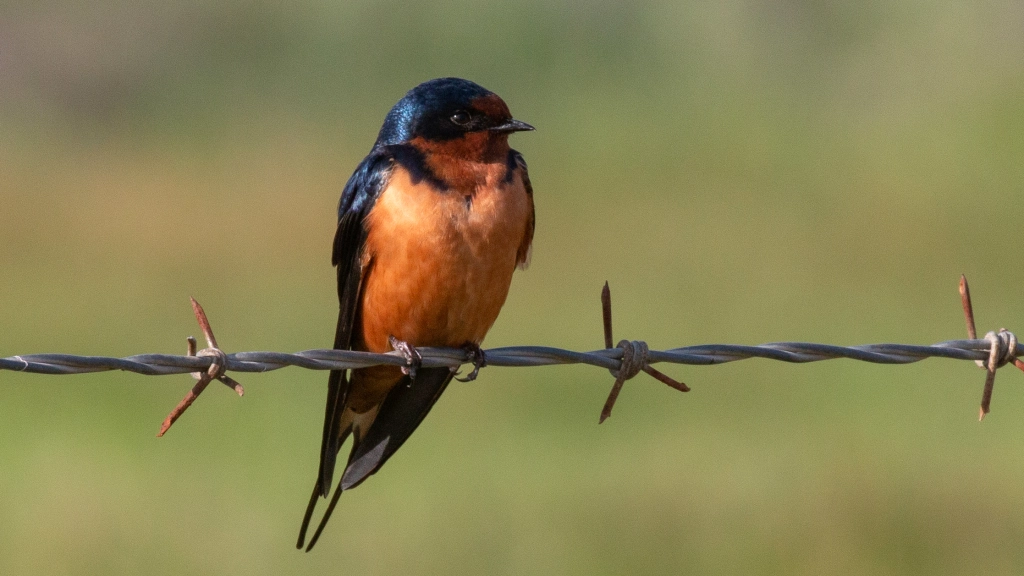An educator and naturalist, Jim Gain is also a superb photographer. We’re proud to publish his series, “Learn 100 Common Valley Birds.” Here is post #16. Be sure to visit Reflections of the Natural World for more of Jim’s fine work. Once there, you’ll be rewarded with a couple of bonus birds for this post. ed.
Tree Swallow – Species #21
The Tree Swallow (Tachycineta bicolor) is a small, insectivorous bird species found throughout the Central Valley of California. These birds are known for their sleek, iridescent blue-green plumage on their backs and wings, contrasting with their white underparts. They have a forked tail and a short, pointed bill, which they use to catch insects on the wing.
Tree Swallows are migratory birds that breed in North America, with some populations wintering in Central and South America. They typically arrive in the Central Valley of California in late February or early March and start breeding in April. These birds are cavity nesters, and they often compete with other species, such as Bluebirds and House Sparrows, for nesting sites. They build their nests in tree cavities, birdhouses, and even nest boxes provided by humans. Tree Swallows lay 4-7 eggs per clutch and raise 1-2 broods per year. Their diet consists mostly of insects, which they catch on the wing, but they may also consume small fruits and berries. Tree Swallows are an important part of the ecosystem, controlling insect populations and serving as prey for larger birds and mammals.

Cliff Swallow – Species #22
The Cliff Swallow (Petrochelidon pyrrhonota) is a migratory bird species that is found in the Central Valley of California during the breeding season, typically from March to September. They are known for their unique mud nests that they build on vertical surfaces such as cliffs, bridges, and buildings. Their nest sites can be quite large, sometimes housing hundreds of birds, and are a common sight in many areas of the Central Valley.
The Cliff Swallow is a highly social bird and is often found in large flocks, both during the breeding season and during migration. They feed mainly on insects, which they catch while in flight, and are known for their acrobatic flying abilities. The breeding cycle of Cliff Swallows begins in early spring, with males arriving first to establish nesting sites and attract females. Once paired, the birds build their mud nests and raise their young, typically producing two broods per season.
Despite their adaptability and success in the Central Valley, Cliff Swallow populations have declined in recent decades due to habitat loss, pesticide use, and other factors. Efforts are underway to monitor and conserve this important bird species, which plays an important role in controlling insect populations and maintaining the ecological balance of the region.

Barn Swallow – Species #23
The Barn Swallow (Hirundo rustica) is a common passerine bird species that can be found in the Central Valley during the breeding season, which typically lasts from March to September. These birds have a distinctive appearance, with a long forked tail, blue-black upperparts, and reddish-buff underparts. The male and female are similar in appearance, but the male typically has longer tail feathers.
Barn Swallows are known for their acrobatic flight and can often be seen darting and swooping over open fields and bodies of water in search of insects, which make up the bulk of their diet. They build their cup-shaped nests out of mud and grass and attach them to the underside of structures such as bridges, eaves, and cliffs. Barn Swallows are also known for their impressive migratory abilities, with individuals traveling thousands of miles each year to their wintering grounds in Central and South America.

In recent years, the Barn Swallow population in the Central Valley of California has been declining due to factors such as loss of nesting sites and pesticide use. Conservation efforts are underway to protect these birds and their habitat, including the installation of artificial nesting structures and the reduction of pesticide use in agricultural areas.

WHERE I LIVE, WHERE MOST OF US LIVE HERE IN THE VALLEY, THERE ARE FEW TREES. SOME PEOPLE SEEM TO HAVE A PHOBIA TO TREES AND TALL GREENRY. I GOT ON MY NEIGHBOR’S BAD SIDE WHEN I INTERFERED WITH HIS CHAIN SAWING DOWN A 50 FOOT PECAN TREE IN HIS YARD. HE TOLD ME HE WAS TIRED OF PICKING UP THE PECANS. I RELISHED THE ONES THAT FELL ON MY SIDE OF THE FENCE. THE FOLIAGE AT THE TOP SPREAD OVER MY HOUSE. THE ONLY TREE ON MY SIDE OF BLOCK. I LOVE THAT TREE AND THE SHADE IT PRODUCED.
THE TROUBLE STARTED BECAUSE HE ASKED ME TO MOVE ALL OF MY FRUIT TREES IN POTS AND 50 OR SO FLOWER FILLED POTS IN CASE THE TREE CAME DOWN IN MY YARD. I WAS NOT ABOUT TO, PLUS I COULD NOT MOVE THE FENCE. THERE WAS ABSOLUTELY NO WAY THE TREE COULD ONLY FALL IN HIS YARD, AND HE AND I KNEW THAT.
I SUGGESTED HE HIRE AN EXPERT. HE CHIDED ME FOR MY NON-COOPERATION.
I STOOD BY AS HE TOOK EVERY LAST BOUGH HE COULD REACH OFF THE PECAN TREE. IT WAS A SAD DAY FOR THAT TREE AND ME.
HIS LADDER WAS ONLY 15 FEET SO HE COULD NOT REACH THE TOP 30 FEET. AS IT WAS BOUGHS CAME DOWN ON THE FENCE AND MY SIDE OF THE YARD. I DID HAVE TO MOVE QUITE A FEW TREES AND PLANTS.
HE GREW ANGRIER AT ME WHEN iI DEMANDED HE STOP. HE WAS ABOUT TO CHAIN SAW THE TRUNK. I WOULD HAVE LOST THE ROOF ON THE CORNER OF THE HOUSE. AND HE LIKELY HIS LIFE FALLING DOWN OFF THE LADDER WITH THE TOP OF THE TREE AND HIS CHAIN SAW.
WHAT GETS INTO STUBBORN PEOPLE?
ANYWAYS, IT IS STILL THE TALLEST PECAN TREE I EVER LAID EYES ON. THE BIRDS STILL LOVE IT, AS DO I. YET I MISS THE SHEER AMOUNT OF BIRDS THAT FROLICED ON ITS BRANCHES.
AND, I MUST ADMIT: I MISS THE PECANS, FOR ONLY 3-4 FALL IN MY YARD, ANY MORE. THEY NEVER DID CARE TO TAKE THE PECANS OFF MY HANDS.
I REMARKED ABOUT ALL THIS HOPING TO CONVEY MY SADNESS THAT SO FEW PEOPLE HAVE THE LUXURY OF A TREE IN THEIR OR A NEIGHBOR’S YARD. FEWER AND FEWER BIRDS HAVE THE LUXURY, EITHER.
WERE IT NOT FOR PHOTOGRAPHERS, SUCH AS JIM GAIN, NEARLY NONE, OF US, CITY DWELLERS, WOULD KNOW WHAT WE WE ARE MISSING.
I RECALL YEARS AGO, PEOPLE TAKING COLLECTIONS ON THE STREETS, FOR MONEY TO BUS CITY CHILDREN TO RURAL AREAS. I FOUND THAT ODD AS I FIRST HEARD IT. UNTIL EXPLANATION WAS GIVEN. I WAS TOLD MANY CITY CHILDREN BARELY KNEW WHAT TREES, IN UNISON, LOOKED LIKE. NOR BIRDS IN FLOCKS, OTHER THAN PIDGEONS.
THAT WAS ANOTHER SAD DAY FOR ME. THINKING DEEPLY, OF ALL THE CHILDREN GROWING UP IN CONCRETE JUNGLES. O MY WHAT HAVE WE DONE?